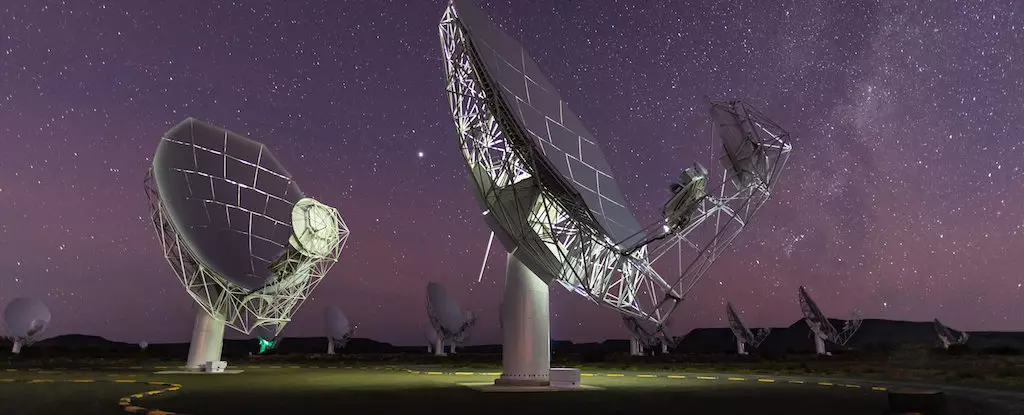Giant radio galaxies (GRGs) represent some of the most fascinating yet elusive structures of the cosmos, stretching over millions of light-years in length. Among these towering giants, a recently discovered galaxy named Inkathazo has piqued the interest of astronomers worldwide. Found using the state-of-the-art MeerKAT telescope in South Africa, Inkathazo not only measures over 3 million light-years but also presents mysterious characteristics that challenge existing astrophysical models.
To appreciate the significance of Inkathazo, it’s essential to understand what distinguishes GRGs from other astronomical entities. Typically, a galaxy’s size can reveal much about its formation, internal dynamics, and the physics governing it. GRGs—defined as radio galaxies larger than approximately 2 million light-years—house supermassive black holes at their centers. These black holes interact with surrounding matter, resulting in the emission of powerful plasma jets that can extend far into space while emitting radio waves. However, the enormity of Inkathazo, which dwarfs our own Milky Way by more than 30 times, challenges many preconceived notions about galactic growth and evolution.
Inkathazo’s discovery is notable not just for its size but also for its peculiar characteristics. As Kathleen Charlton, the lead researcher from the University of Cape Town, pointed out, the galaxy’s jets possess an unusual shape, deviating from the typical straight-line trajectory seen in most GRGs. One prominent jet appears bent, raising questions about the mechanisms behind plasma jet formation and propagation in such massive structures. This eccentricity is amplified by the galaxy’s location: Inkathazo resides within a cluster of other galaxies where conditions typically inhibit the development of colossal jets, making its existence an exciting anomaly.
The discovery of Inkathazo serves as a testament to the shifting landscape of astronomical research. Kshitij Thorat, an astronomer involved in the project, emphasized that finding a GRG amid a densely populated cluster of galaxies raises compelling questions about the role of environmental interactions in galactic evolution. The complexity of these cosmic relationships could provide insights into the non-linear growth patterns of galaxies, suggesting that environmental factors may significantly shape their characteristics.
To further decipher Inkathazo’s mysteries, researchers utilized MeerKAT to create detailed spectral age maps of the galaxy. These maps unveil the varying ages of plasma across different regions, offering clues about the energy dynamics at play. Remarkably, the study revealed unexpected energy boosts in particular areas of the jets. Such increases in energy levels could indicate external influences, possibly from interactions with hot gases in its galactic cluster. This newfound understanding underscores the importance of considering surrounding cosmic neighborhoods in understanding the physics of GRGs.
The advent of sophisticated radio telescopes, such as MeerKAT, has transformed the way astronomers explore the universe. The recent surge in discoveries of GRGs is a testament to the enhanced observational capabilities these instruments offer. The burgeoning list of GRGs found in the past five years reflects a growing understanding of the universe’s complexity, revealing that many astronomical phenomena were overlooked or misunderstood due to technological limitations.
Charlton pointed out that most of the GRGs identified thus far have been tracked from telescopes in the Northern Hemisphere. However, the exciting findings emerging from Southern Hemisphere observations, particularly through the MeerKAT telescope, signal a probable treasure trove of hidden GRGs in the skies above Africa. Inkathazo is one of three recently identified GRGs in a single observational sweep, showcasing the untapped potential for future discoveries in this area of research.
As our understanding of galaxies continues to evolve, it becomes increasingly clear that many mysteries remain to be unraveled. The peculiar features of Inkathazo not only challenge our current models but also inspire new inquiries into the formation and evolution of GRGs. Although once considered rare, these cosmic giants have astounded astronomers with their frequency of discovery, particularly as advanced telescopes unveil details previously unnoticed.
Inkathazo serves as an emblem of the vast intricacies of the universe, blending size, mystery, and advanced technology into a singular narrative of discovery. As we journey deeper into cosmic exploration, this giant radio galaxy stands as a reminder that the universe’s secrets, though initially obscured, are always poised to be revealed. The exciting potential that lies ahead beckons researchers to delve into the cosmic unknown and continue to challenge our understanding of the fabric of the universe.

